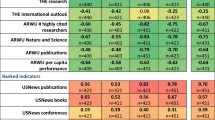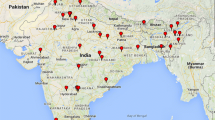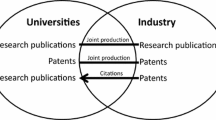Abstract
The problem of comparing academic institutions in terms of their research production is nowadays a priority issue. This paper proposes a relative bidimensional index that takes into account both the net production and the quality of it, as an attempt to provide a comprehensive and objective way to compare the research output of different institutions in a specific field, using journal contributions and citations. The proposed index is then applied, as a case study, to rank the top Spanish universities in the fields of Chemistry and Computer Science in the period ranging from 2000 until 2009. A comparison with the top 50 universities in the ARWU rankings is also made, showing the proposed ranking is better suited to distinguish among non-elite universities.

Similar content being viewed by others
References
Adler, N., & Harding, A.-W. (2009). When knowledge wins: Transcending the sense and nonsense of academic rankings. The Academy of Management Learning and Education, 8(1), 72–95.
Aguillo, I. F., Bar-Ilan, J., Levene, M., & Priego, J. L. O. (2010). Comparing university rankings. Scientometrics, 85(1), 243–256.
Aksnes, D. (2003). Characteristics of highly cited papers. Research Evaluation, 12, 159–170.
Aksnes, D., & Sivertsen, G. (2004). The effect of highly cited papers on national citation indicators. Scientometrics, 59, 213–224.
Alonso, S., Cabrerizo, F., Herrera-Viedma, E., & Herrera, F. (2009). h-Index: A review focused in its variants, computation and standardization for different scientific fields. Journal of Informetrics, 3(4), 273–289.
Billaut, J.-C., Bouyssou, D., & Vincke, P. (2010). Should you believe in the Shanghai ranking?: An MCDM view. Scientometrics, 84(1), 237–263.
Bornmann, L., & Daniel, H.-D. (2008). Selecting manuscripts for a high-impact journal through peer review: A citation analysis of communications that were accepted by Angewandte Chemie International Edition, or rejected but published elsewhere. Journal of the American Society for Information Science and Technology, 59(11), 1841–1852.
Bornmann, L., & Daniel, H.-D. (2008). What do citation counts measure? A review of studies on citing behavior. Journal of Documentation, 64(1), 45–80.
Bornmann, L., Mutz, R., & Daniel, H.-D. (2010). The h index research output measurement: Two approaches to enhance its accuracy. Journal of Informetrics, 4(3), 407–414.
Buela-Casal, G., Gutiérrez-Martínez, O., Bermúdez-Sánchez, M. P., & Vadillo-Muñoz, O. (2007). Comparative study of international academic rankings of universities. Scientometrics, 71(3), 349–365.
Cabrerizo, F., Alonso, S., Herrera-Viedma, E., & Herrera, F. (2010). q2-Index: Quantitative and qualitative evaluation based on the number and impact of papers in the Hirsch core. Journal of Informetrics, 4(1), 23–28.
Dehon, C., McCathie, A., & Verardi, V. (2010). Uncovering excellence in academic rankings: A closer look at the Shanghai ranking. Scientometrics, 83(2), 515–524.
Dill, D. D., & Soo, M. (2005). Academic quality, league tables, and public policy: A cross-national analysis of university ranking systems. Higher Education 49, 495–533. doi:10.1007/s10734-004-1746-8.
Egghe, L. (2006). Theory and practise of the g-index. Scientometrics, 69(1), 131–152.
Elsevier B.V. Scopus. (2010). See http://www.scopus.co. Accessed Oct 2010.
Hirsch, J. E. (2005). An index to quantify an individual’s scientific research output. Proceedings of the National Academy of Sciences USA, 102(46), 16569–16572.
ISI Web of Science. Science Citation Index. See http://isiknowledge.co. Accessed Oct 2010.
Kosmulski, M. (2009). New seniority-independent Hirsch-type index. Journal of Informetrics, 3(4), 341–347.
Leydesdorff, L., & Opthof, T. (2010). Normalization, CWTS indicators, and the Leiden Rankings: Differences in citation behavior at the level of fields. http://www.leydesdorff.net/reply2cwts/reply2cwts.pd. Accessed Oct 2010.
Liu, N. C., & Cheng, Y. (2005). Academic ranking of world universities: Methodologies and problems. Higher Education in Europe 30(2), 127–136.
Moed, H. F. (2005). Citation analysis in research evaluation. New York: Springer.
Moed, H. F. (2010). CWTS crown indicator measures citation impact of a research group’s publication oeuvre. CoRR, abs/1003.5884.
Price, D. J. D. S. (1965). Networks of scientific papers. Science, 149(3683), 510–515.
QS World University Rankings. (2010). http://www.topuniversities.com/university-rankings/world-university-rankings/hom. Accessed Oct 2010.
SCImago Institutions Rankings. (2007). http://www.scimagoir.co. Accessed Oct 2010.
Shanghai Jiao Tong University. ( 2009). Academic ranking of world universities (ARWU). http://www.arwu.org/index.js. Accessed Oct 2010.
Sypsa, V., & Hatzakis, A. (2009). Assessing the impact of biomedical research in academic institutions of disparate sizes. BMC Medical Research Methodology, 9, 33–42.
Universiteit Leiden. (2010). Leiden university rankings. http://www.socialsciences.leiden.edu/cwts/products-services/leiden-ranking-2010-cwts. Accessed Oct 2010.
van Raan, A. F. J., van Leeuwen, T. N., Visser, M. S., van Eck, N. J., & Waltman, L. (2010). Rivals for the crown: Reply to Opthof and Leydesdorff. Journal of Informetricx, 4(3), 431–435.
Vieira, E., & Gomes, J. (2010). A research impact indicator for institutions. Journal of Informetrics, 4(4), 581–590.
Acknowledgements
Jose García Moreno-Torres is currently supported by a FPU grant from the Ministerio de Educación y Ciencia of the Spanish Government. The authors would like to thank Nicolás Robinson García for reviewing the manuscript.
Author information
Authors and Affiliations
Corresponding author
Rights and permissions
About this article
Cite this article
Torres-Salinas, D., Moreno-Torres, J.G., Delgado-López-Cózar, E. et al. A methodology for Institution-Field ranking based on a bidimensional analysis: the IFQ 2 A index. Scientometrics 88, 771–786 (2011). https://doi.org/10.1007/s11192-011-0418-6
Received:
Published:
Issue Date:
DOI: https://doi.org/10.1007/s11192-011-0418-6




